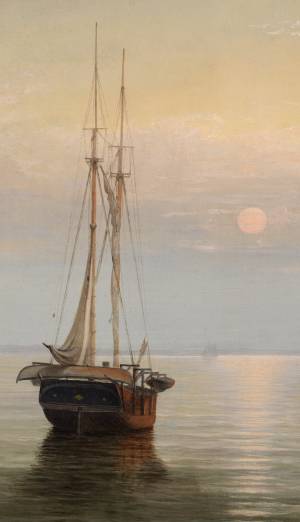An online project under the direction of the CAPE ANN MUSEUM
Historical Materials: Maritime & Other Industries & Facilities
Historical Materials » Maritime & Other Industries & Facilities » Whale Fishery
Whale Fishery
View related Fitz Henry Lane catalog entries (3) »
Given the preeminence of fishing and the foreign trade in Gloucester, it is hardly surprising that Lane gave so little attention to the whale fishery which was barely existent in seaports north of Cape Cod. Gloucester merchants made attempts at whaling in two periods: 1788–96 and 1833–36 with one other voyage in 1853-1854 and a failed attempt in the 1840s - ten voyages in a 60-year time span. There were whaling voyages out of nearby ports—Beverly, Salem, Lynn, and Boston—all on a similar scale, barely noticeable by comparison with other mercantile activity, not to mention the thriving whaling industry in New Bedford. (1)
While Lane made a lithograph of the port of New Bedford in View of New Bedford / From the Fort Near Fairhaven, 1845 (inv. 313), it was from another artist's drawing. There is no record of his having visited that city until 1856, when he observed and sketched the New York Yacht Club's regatta for a subsequent series of paintings (see New York Yacht Club Regatta (1), 1856 (inv. 66), New York Yacht Club Regatta (2), 1856 (inv. 270), New York Yacht Club Regatta (3), After 1856 (inv. 396), New York Yacht Club Regatta (4), 1857 (inv. 397)). There is also no evidence that he remained in New Bedford for any length of time to depict whaling vessels. As with New Bedford artist William Bradford and Albert van Beest, had friction developed between Lane and Bradford, who was also busy with his own depiction of the regatta? (2)
Lane's only known depiction of a whaling vessel—a whaling schooner—is apparently set in New York Harbor, probably at the time of his first visit (on record) to that city, in 1850. The schooner's hull and rig are typical for the period, the only jarring detail being two pairs of davits on the starboard (right-hand) side for the whaleboats when there should be only one. The forward davits and whaleboat should be on the port (left-hand) side, leaving the starboard midships unobstructed for cutting-in and boarding the whale's "blanket piece" (a wide strip if skin and blubber peeled continuously in a spiral). Given the possibility that this schooner hailed from a New York-based port with its own ideas of whaling, Lane may have rendered accurately a very atypical davit configuration. The whaleboats—including the one approaching the schooner—are accurately depicted. (3)
– Erik Ronnberg
References:
1. Alexander Starbuck, "History of the American Whale Fishery from Its Earliest Inception to the Year 1875", in Report of the Commissioner for 1875-76 (Washington: U.S. Commission of Fish and Fisheries, 1878), in tables showing returns of whaling vessels for ports and years cited.
2. Richard C. Kugler, "William Bradford", in Richard C Kugler (editor), William Bradford: Sailing Ships & Arctic Seas (New Bedford, Seattle, and London: New Bedford Whaling Museum and the University of Washington Press, 2003), 8–9.
3. G. Brown Goode, The Fish and Fisheries of the United States, Section V, Plates (Washington: Government Printing Office, 1887), see plates 185, 186, 188, 190.
Oil on canvas
24 x 26 1/4 in.
Cape Ann Museum, Gloucester, Mass., Estate of Catalina Davis, 1932 (642.13b)
This is the only known depiction of a whaling schooner (detail) in Lane's work, believed to be in New York Harbor.
View related Fitz Henry Lane catalog entries (1) »
Also filed under: Schooner (Whaling) »
